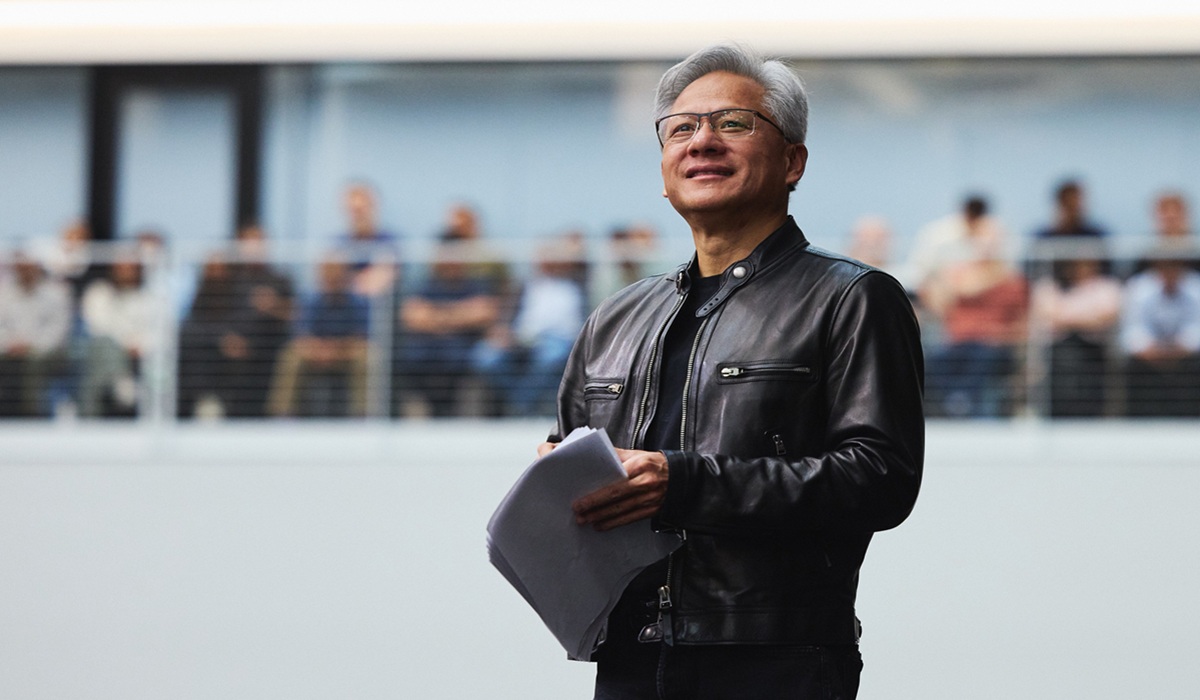From 95% to Zero: Trump’s Trade Wars Pushed Nvidia Out of China and Rewired the Global Economy
- Naomi Dela Cruz
- Business
- Trending News
- October 22, 2025

Image Credit: Nvidia
When Jensen Huang, the CEO of Nvidia, sat down for an interview on Tuesday, his tone was not defiant or defensive—it was somber. He spoke like a man watching a masterpiece being dismantled. Nvidia, the crown jewel of America’s semiconductor industry, had gone from owning 95 percent of China’s AI chip market to virtually zero. The cause, he said, wasn’t competition or innovation—it was politics.
The collapse of Nvidia’s Chinese market share wasn’t gradual; it was surgical. Successive waves of trade restrictions, sanctions, and policy moves tied to Donald Trump’s revived trade war have systematically shut American chipmakers out of China. Once a thriving ecosystem of partnership and profit, the world’s second-largest economy has now become an off-limits zone for the company that helped build the modern AI era.
“Before we leap towards policies that are hurtful to other people, take a step back and maybe reflect on what are the policies that are helpful to America,” Huang said. His words cut through the noise of economic nationalism and spoke to a deeper truth: self-inflicted isolation rarely leads to strength.
The U.S.–China chip war, reignited and intensified under Trump’s second administration, has been framed as a national security imperative. But in reality, it’s become an economic boomerang. America’s attempt to contain China’s technological rise has not stopped it—it has accelerated it. Chinese firms are now racing to develop their own GPUs and AI chips, building a domestic ecosystem that may one day surpass what the U.S. chose to abandon.
For Nvidia, the consequences are immediate and quantifiable. The company once generated nearly a quarter of its data-center revenue from China. That stream has dried up. The customers who once relied on American technology are now turning inward, fostering a new breed of domestic innovation. In trying to keep the keys to the kingdom, the United States may have locked itself out of the palace altogether.
But the implications extend beyond semiconductors. This is a mirror reflecting the broader damage of the Trump-era trade doctrine—a doctrine built not on strategy, but impulse. The same aggressive tactics that fractured the global chip supply chain are echoing across industries. American farmers, who once shipped soybeans and grain by the ton to Chinese ports, now face shrinking orders and volatile markets. Retaliatory tariffs, nationalist boycotts, and disrupted supply routes have left many wondering how “America First” became “America Alone.”
Huang’s frustration mirrors that of countless executives and policymakers who see the United States dismantling its own leverage in the global economy. The country that once wrote the rules of trade and technology is now enforcing walls that limit its reach. Every sanction that cuts off access to foreign markets chips away at the dominance of the dollar, the supremacy of U.S. innovation, and the soft power that once kept allies close.
The world is watching, and reacting. Across Asia, Europe, and the Middle East, governments are quietly exploring alternatives to U.S.-centric systems. Currencies such as the Chinese yuan, the Indian rupee, and even decentralized digital assets are gaining traction as hedges against the volatility of U.S. policy. The BRICS bloc—once seen as a symbolic alliance—is now becoming a serious counterweight, discussing shared payment systems and trade structures independent of Washington’s influence.
This slow-motion shift represents something more profound than economics; it’s the erosion of trust. Nations and corporations alike are recalibrating to survive in a world where American policy can change overnight. Investors, once confident that the U.S. was the safest bet, are diversifying into other currencies, other markets, other alliances. The center of gravity in global finance is moving, inch by inch, away from New York.
Back home, the social consequences are no less severe. As the economy convulses under the strain of tariffs and fractured trade routes, America itself feels increasingly divided. Rural communities that once thrived on exports now face bankruptcy. Manufacturing towns that were promised a revival see only higher costs and fewer buyers. Healthcare workers, researchers, and academics are joining a quiet exodus, seeking stability abroad in countries that still prize science, diversity, and open collaboration.
In many ways, this is the same script being replayed across sectors: alienate your partners, punish your innovators, and watch others fill the vacuum. The chip industry may be the most visible casualty, but it’s only a symptom of a deeper malaise. When ideology replaces pragmatism, and revenge replaces vision, even the strongest economies start to crumble.
For decades, Nvidia symbolized the power of American ingenuity. Its chips fueled breakthroughs in AI, medicine, and science. Its success was global because its market was global. But when politics replaced partnership, that success story turned into a cautionary tale. In pushing out China, the U.S. didn’t just lose a market—it lost momentum.
Huang’s warning should not be dismissed as corporate frustration. It’s a lesson in interconnectedness. Cutting off the world’s largest pool of AI researchers and engineers doesn’t make America safer or richer—it makes it smaller. By isolating itself, the U.S. is conceding leadership in industries it once defined.
The broader consequences are still unfolding. As countries pivot to new trade systems and alternate currencies gain legitimacy, the dollar’s reign as the global standard faces its most serious challenge in decades. Combined with political division, institutional fatigue, and a brain drain of talent, the nation risks not only economic decline but cultural irrelevance.
Trump’s policies, however well-intentioned in rhetoric, have left deep cracks across the foundations of the American economy. Farmers lost their markets. Chipmakers lost their access. Universities lost their scholars. And through it all, the idea of American leadership—built on openness, excellence, and reliability—has faded into something narrower and meaner.
When the dust settles, historians may look back on this era not as one of resurgence, but regression. The United States, once a beacon of trade and innovation, turned inward at the height of its power. In doing so, it may have sparked the rise of a multipolar world, one less dependent on Washington’s approval and more determined to build its own path.
Jensen Huang’s words, delivered with calm precision, capture the moment better than any political slogan: before we leap toward policies that are hurtful to others, we should reflect on the policies that are actually helpful to America. The tragedy is that the warning may come too late.
The decline from 95 percent to zero is not just Nvidia’s story—it’s America’s.








